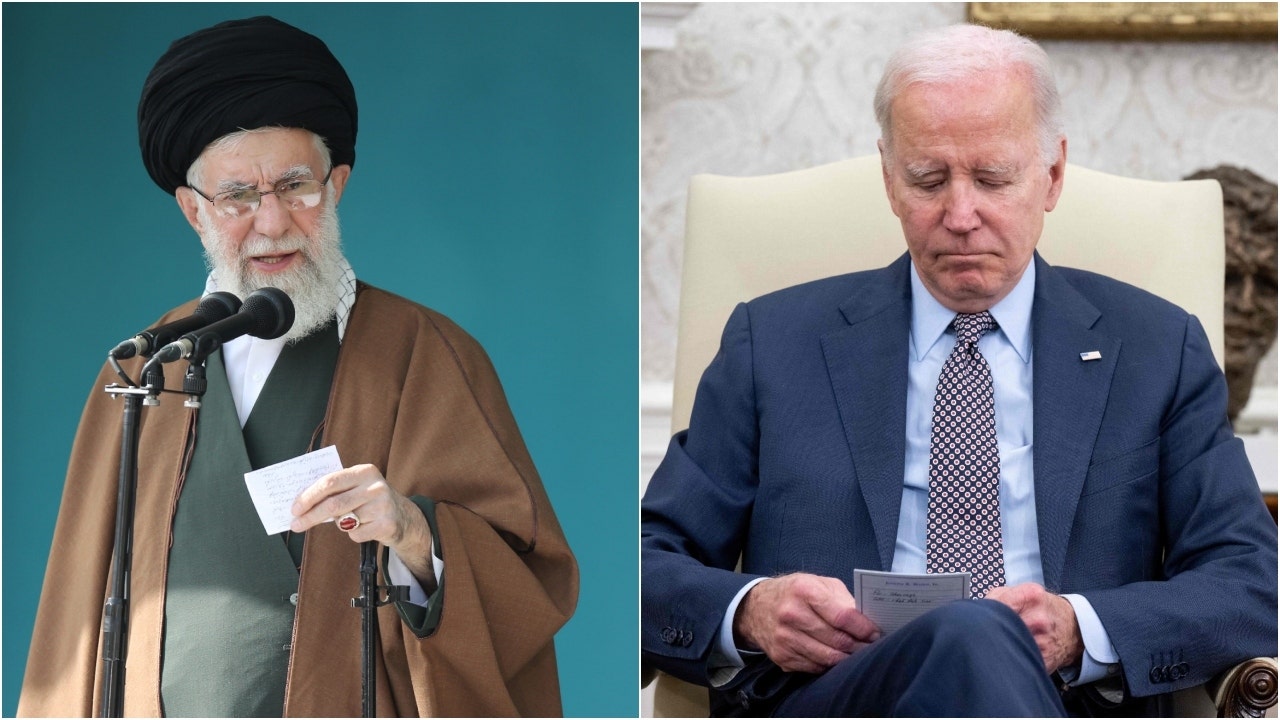Sports
How the House v. NCAA settlement could reshape college sports: What you need to know

Big 12 presidents and chancellors voted to approve proposals of what is expected to be a multi-billion dollar settlement in the House v. NCAA class-action lawsuit Tuesday, a source briefed on the decision confirmed to The Athletic. Their approval is another step toward a resolution in the landmark case likely to reshape the college sports business model.
The Big 12 is the first of the suit’s defendants to vote on the settlement terms, with the remaining power conferences and NCAA Board of Governors also expected to do so this week. It’s expected the settlement will cost them nearly $3 billion in damages and allow power-conference athletes to finally share in annual revenues.
House v. NCAA seeks back pay for Division I college athletes who were barred from earning name, image and likeness (NIL) compensation prior to the NCAA changing its policy in summer 2021, while also pursuing a cut of future broadcast revenues for athletes at power-conference schools.
As college sports face a reckoning on multiple fronts, and with the prospect of the NCAA owing as much as $20 billion in damages were it to lose the House case at trial, settlement efforts intensified in recent weeks.
In addition to more than $2.7 billion in NIL back-pay damages, a settlement would include a system in which roughly $20 million a year can be distributed directly from a power-conference school to its athletes, multiple people briefed on the negotiations confirmed to The Athletic.
All indications are that the last vestiges of amateurism in college sports are coming to an end.
“I expect the athletes who are generating the most money would get the greatest economic return,” said Jeffrey Kessler, one of the lead lawyers representing the plaintiffs. “That’s the economic competitive market we live in.”
A House settlement would be the next legal domino in what has been a busy stretch of forced change for the NCAA, including the U.S. Supreme Court unanimously upholding the NCAA v. Alston decision in 2021 and agreeing that the NCAA’s cap on education-related expenses was an antitrust violation. State legislatures helped usher in the NIL era weeks later. Lawsuits filed by multiple state attorneys general have since forced the NCAA to halt enforcement of NIL regulations and allow multi-time transfers immediate eligibility.
Over the past three years, these lawsuits and policy changes have created (and exposed) cracks in the foundation of the collegiate model.
GO DEEPER
Why is the NCAA proposing a new subdivision? Explaining the related legal battles
“The most important part about the settlement — and let’s face it, there’s still a lot of work to be done there — is it creates some clarity and some visibility on a whole bunch of issues that have sort of been roiling everybody for a while,” NCAA president Charlie Baker said last week. “The other thing it does is create predictability and stability for schools. It creates a tremendous opportunity for student-athletes.”
So what does this mean for fans of college sports? Most immediately, it simply means that the power-conference programs you follow and root for, which bring in millions of dollars in revenue annually from television contracts and ticket sales, can start paying athletes with that money — a significant budgetary adjustment, but not so functionally different from how school-affiliated NIL collectives have started paying players.

GO DEEPER
College football portal confidential: How tampering, NIL deals and portal chaos happen
Yet in the broader scope, this settlement will further widen the gap between high-major revenue sports — particularly power-conference football — and the rest of college athletics. It’s another step toward a future in which the biggest programs stratify or fully separate from the rest of the NCAA into some version of super conferences or a super league. To that end, there’s also been some organized, internal pushback within the NCAA from smaller Division I conferences that believe they will be forced to shoulder a disproportionate amount of the damages in the proposed settlement.
Plenty of hurdles remain beyond the House case as well, including whether athletes will ultimately unionize and/or be deemed employees, or if the NCAA can secure antitrust exemptions from Congress. Regardless, big changes are on the horizon, and in a way the NCAA has long fought.
Here’s more on what’s at stake in House v. NCAA, and what could come next.
Potential settlement details
The NCAA is backed into a corner.
House v. NCAA was filed in June 2020 with Grant House, a former Arizona State swimmer, and Sedona Prince, a former Oregon and current TCU women’s basketball player, as the two named plaintiffs. In November, U.S. District Court Judge Claudia Wilken, who has a track record of ruling against the NCAA in similar cases (O’Bannon, Alston), granted class-action certification for the damages portion of the House case, expanding it to any Division I athlete dating back to 2016 (in accordance with a four-year statute of limitations).
This exponentially elevated the potential cost — and impact — of the case, which is currently scheduled to go to trial in January 2025.
U.S. antitrust laws grant plaintiffs three times the damages they are awarded — known as “treble damages” — meaning if the NCAA lost at trial, it would automatically be on the hook for triple the damage amount ordered by the judge. According to documents circulated among power conference presidents and administrators and obtained by Yahoo Sports, that final class-action figure could be as high as $20 billion, and enough to force the NCAA to file for bankruptcy.
A loss at trial would also strike down any existing constraints on NIL.
“So essentially, if we win, there would be a complete free market in NIL, including from broadcast payments,” said Kessler.
The combination of triple damages, which would likely have to be paid out immediately, and the NIL floodgates fully opening would be a death rattle for the NCAA, and why a settlement is seen as the surest path to the organization’s survival, at least in the short term.
Through a spokesperson, the NCAA declined to comment.
Certain details of the settlement, though not finalized, have been reported by multiple outlets and confirmed to The Athletic. The nearly $3 billion in back-pay damages would be paid out over 10 years, and power-conference programs could opt into the annual $20 million revenue-sharing allocation likely starting with the 2025-26 season.
This would coincide with a change in roster limits that would eliminate existing caps on scholarships, such as a baseball team’s 11.7 scholarships that get divvied up among 30-plus players. If the baseball roster limit was set at 25, for example, schools would have 25-player teams and could fully fund up to 25 scholarships. This impacts football as well, where teams currently have 85 allotted scholarships but can carry up to 115 total players on the roster. There’s fear among coaches that the new roster limit could eliminate walk-ons.
“Our game is not the pro game,” said Wake Forest coach Dave Clawson, a member of the American Football Coaches Association board. “We get players that need to be taught and coached when they come out of high school. …(In the NFL), they have a practice squad, they have access to players and other teams. Once we start practice, our roster is set for the year, and they have to be students.”
ACC commissioner Jim Phillips said those roster determinations would be “local decisions” for each university, with better-resourced schools likely to do more than others within the Power 4 leagues. Roster limits are expected to be part of Thursday’s vote by the conferences, and multiple administrators told The Athletic that they expect specific scholarship figures to be decided collectively by the Power 4 conferences in the coming months.
What the NCAA could avoid with a settlement
The compromises of a possible House settlement are obvious, but so are the benefits. The NCAA doesn’t risk the immediately payable treble damages at trial and can negotiate terms on a revenue-sharing model while maintaining a similar operating structure.
College athletes receive scholarships and other benefits, but the anticipated rate of revenue sharing wouldn’t be nearly as high as their counterparts in the pros. The roughly $20 million annual amount represents 22 percent of the average Power 4 school’s annual revenue. Revenue sharing in the major American professional sports is usually around 50 percent for the players.
A settlement would also address another major NCAA issue by simultaneously resolving other high-profile antitrust cases, including Hubbard v. NCAA and Carter v. NCAA; plaintiffs in both cases are also represented by Steve Berman and Kessler.
Hubbard is similar to House in the sense that it is seeking retroactive damages for education-related Alston payments; Carter argues that rules prohibiting college athletes from receiving “pay for play” violate antitrust law. A House settlement would resolve each of them.
One other antitrust case factors in: Fontenot v. NCAA, a separate, class-action suit filed in Colorado that is seeking similar claims and damages as Carter. A motion to transfer the case to the same Northern District of California court as the other antitrust suits has been requested, ostensibly to have it resolved by a settlement in the House case. A hearing on the transfer is also set for Thursday.
Resolving all four antitrust cases — House, Hubbard, Carter and Fontenot — is a crucial aspect of the settlement for the NCAA, according to people briefed on the negotiations.
“In the current world we live in, planning is very hard to do,” Baker said. “If we can land this thing … I think it creates a lot of stability and clarity for schools. And it makes it possible for all of us to start thinking about what the next act will look like as it rolls out instead of feeling like you’re waiting for the next shoe to drop.”
How it would work
Assuming the NCAA and power conferences sign off on terms this week, there would still be a number of steps to complete a settlement, including official filing, an approval from Judge Wilken and a 90-day period for review and any objections.
If approved, the power-conference revenue sharing will be optional, and there are no specifications on how the money will be distributed, as long as it stays within the capped allotment.
It’s expected that most if not all power-conference programs will opt in to some degree of revenue sharing in order to remain competitive. But even for a number of the schools at that level, it could be a gradual financial process that requires cuts elsewhere.
“As it currently stands, I don’t know many schools that will be able to pay even remotely close to ($20 million) without eliminating some portion of what they currently spend,” said Iowa State athletic director Jamie Pollard.
For back-pay damages, the NCAA would use its reserves to cover $1.1 billion, and the remaining approximately $1.6 billion would come from withheld revenue distributions, chiefly via the NCAA men’s basketball tournament credits. Of that $1.6 billion, nearly 60 percent is expected to come from leagues outside the Power 4 conferences (including the Group of 5), according to people familiar with the settlement proposal.
The 22 smaller, non-FBS conferences (colloquially referred to as the CCA22) were not initially briefed on the settlement talks until earlier this month, multiple administrators said, once the financial structure of payouts had already been formulated.
One Division I commissioner estimated that non-FBS conferences would be on the hook for $2.5 million per year to help cover the NCAA’s costs of the settlement. Two sources in different CCA22 leagues said that equates to roughly 25 percent of the annual revenue those schools receive from the NCAA. That level of reduction could lead to cutting sports and athlete resources, despite a lawsuit that was clearly aimed at power-conference schools with the most lucrative media deals.
“The burden that’s being pushed to us is not following any sort of logic as it relates to the court order,” one non-Power 4 source said.
However, the damages payment model that is being voted on is a slightly tweaked version of the original breakdown put forth by the NCAA, a college administrator briefed on the proposal told The Athletic. That’s despite the non-FBS leagues submitting a formal request to the NCAA’s Board of Governors and Division I Board of Directors on Monday, according to sources briefed on the proposal, asking to either delay a final decision on the financial breakdown or adjust it to an equivalent rate of revenue reductions for each conference. The latter would have made the power conferences responsible for roughly 60 percent of the damages.
The Board of Directors and Board of Governors (the NCAA’s highest governing body) are also scheduled to vote on settlement details this week, including authorizing the NCAA to use its financial reserves.
Another area to be addressed is how the terms of a settlement apply to the new classes of athletes each year. Berman mentioned a potential solution.
“Every year, when an NCAA athlete reports in to start the year, they could be given a copy of the class notice and the settlement, and given an opportunity to object within a few months receiving that notice,” said Berman.
Jim Cavale, the founder of the players organization Athletes.org, questions the forward-looking part of the settlement, saying it lacked athlete input. His organization includes about 1,500 power-conference athletes and recently signed up the entire UAB football team.
“How involved are the current athletes?” he said. “On top of that, how involved if at all are future athletes on these terms? The answer is not at all. The results of a (collective bargaining agreement), the terms of the athlete experience and even these caps are not really the responsibility of these plaintiffs’ lawyers in a class-action lawsuit.”
Some industry sources believe there could be less incentive or motivation for players to unionize once they’re getting a piece of the pie. Cavale disagrees.
“Should it be approved, if we got 500 of our 3,000 athletes to object, the way it’s written, you’re going to have 500 different hearings,” he said.
Other unknowns
Plenty more questions remain.
• How will Title IX apply to revenue-sharing distributions? Will proportional payments need to be made to male and female athletes in order to remain compliant — meaning an athletic department can’t spend all or most of its revenue-sharing dollars on football or other men’s sports — or would schools argue that proportional scholarship opportunities satisfy Title IX? This is not something that can be stipulated by the settlement and could be challenged in court. Multiple administrators at Power 4 schools told The Athletic they believe the total dollar figure needs to be equal between male and female athletes, but that their understanding is that each school can determine how to allot the money between its athletes and sports.
• How would this impact potential unionizing and collective bargaining ventures?. Unionizing efforts by the Dartmouth men’s basketball team and national advocacy organizations such as Cavale’s Athletes.Org and the College Football Players Association have yet to gain widespread support, a challenge within something as wide-ranging and transient as college sports. But the topic could receive renewed attention in the wake of a settlement, along with the ongoing discussion of whether college athletes should be deemed employees, which is at the heart of both the Johnson v. NCAA suit and a National Labor Relations Board complaint against USC, the Pac-12 and the NCAA.
In any event, settling House and resolving the other prominent antitrust lawsuits will not fully shield the NCAA from future legal battles, which is why Baker and the organization will continue to pursue Congressional antitrust exemptions.
“(A settlement) creates a framework that makes it possible to then have a different kind of conversation with Congress,” said Baker. “So, in many ways, I’m hopeful.”
• What about NIL collectives? A settlement wouldn’t fully address the role of these third-party organizations and the culture of pay for play, though Yahoo Sports reported that the informational documents it obtained mentioned “economic incentives” for athletic departments to bring collectives in-house.
• How will the financial adjustments trickle down? Will schools decide to cut athlete benefits, administrative positions or entire sports? Will this finally stem the tide of ballooning, seven-figure annual coaching salaries, bloated staffs and multi-million-dollar buyouts? Wholesale changes to the structure of collegiate athletics and the NCAA’s governance remain likely years away, but that doesn’t mean reverberations won’t be felt sooner in other areas.
“It could be the sports you sponsor,” Pollard said. “It could be what you do for the sports you sponsor. It could be the number of staff you have in football. It could be the number of players you have on a football team. Everything’s going to be on the table.”
—The Athletic’s Chris Vannini and Scott Dochterman contributed reporting.
(Photo Illustration: Pavlo Gonchar / SOPA Images / LightRocket via Getty Images)

Sports
Oilers evade Stanley Cup Final sweep in dominant scoring barrage over Panthers
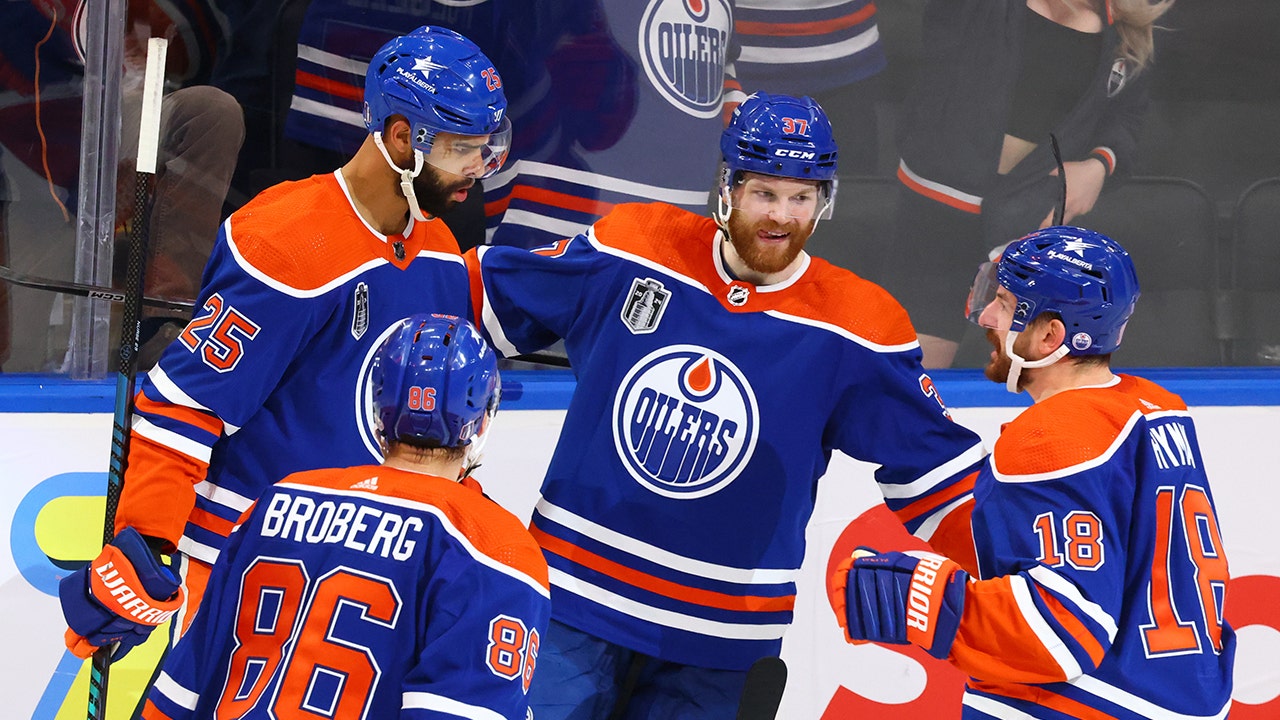
If the Edmonton Oilers have hopes in becoming the second team to win a Stanley Cup Final after trailing the series three games to none, then Saturday’s thumping of Florida was a good start.
The Oilers avoided a sweep in dominant fashion on Saturday night, beating the Florida Panthers, 8-1.
Early in the first period, the Panthers were on the power play, and a shot rang off the post. But after a turnover, the Oilers had a 2-on-1, and Mattian Janmark found the back of the net off a patient feed from Connor Brown. A few minutes later, Adam Henrique scored to give the boys from the land up north a 2-0 lead, but Florida answered right back with a goal by Vladimir Tarasenko to cut the lead in half.
Edmonton Oilers defenseman Darnell Nurse (25) celebrates a goal with teammates in the second period against the Florida Panthers in game four of the 2024 Stanley Cup Final at Rogers Place. (Sergei Belski-USA TODAY Sports)
Edmonton, though, quickly returned the favor. This time it was Dylan Holloway on a nifty pass from Leon Draisaitl to make it 3-1 Oilers. It was Draisaitl’s first point of the series, and it was the first time the Oilers led by two goals all series.
The scoring barrage continued in the second, as Connor McDavid finally scored his first goal of the Cup Final. It didn’t stop there.
Darnell Nurse joined the fun at the 4:59 mark of the period, forcing the Panthers to replace Sergei Bobrovsky with Anthony Stolarz. Ryan Nugent-Hopkins scored on a two-man advantage later in the period, and Holloway and Ryan Mcleod each added another in the third, just in case.
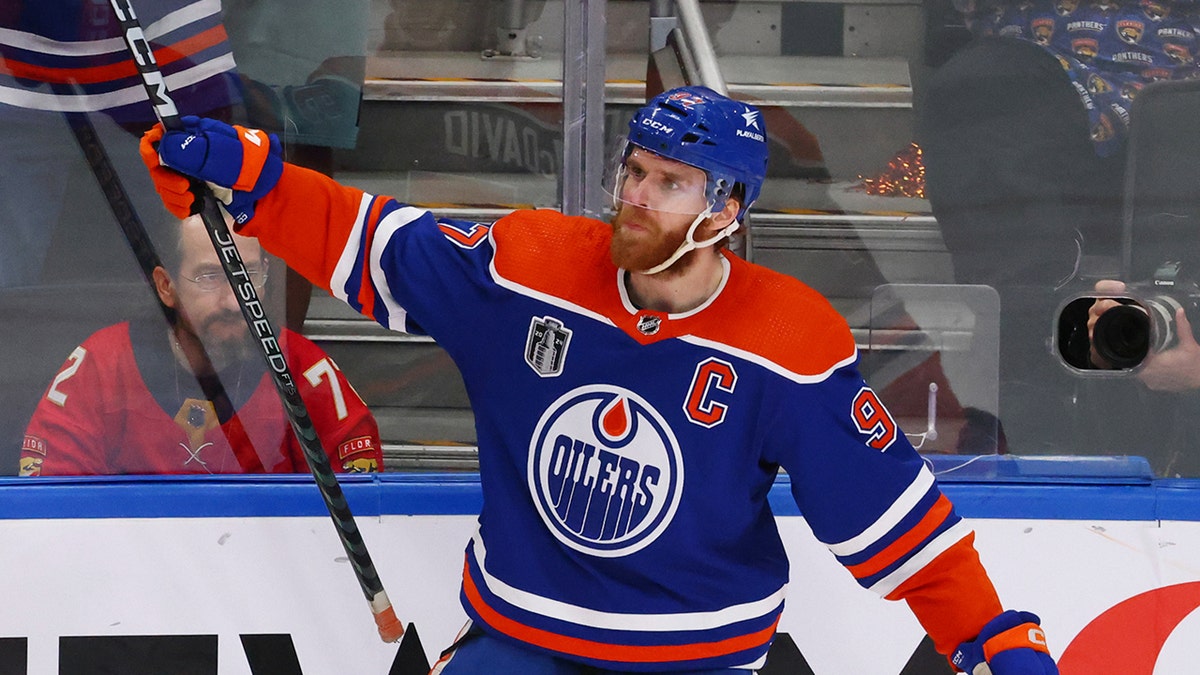
Edmonton Oilers center Connor McDavid (97) celebrates a goal in the second period against the Florida Panthers in game four of the 2024 Stanley Cup Final at Rogers Place. (Sergei Belski-USA TODAY Sports)
The Oilers are looking to become the fifth team in NHL history to win a series after trailing 3-0, and the first since the 2014 Los Angeles Kings did so in the first round – they wound up winning the Cup that year after winning two more Game 7s.
The only comeback in the Cup Final was in 1942 by the Toronto Maple Leafs – it was the first 3-0 comeback in the Big 4 leagues.
Five other teams forced, but lost, a Game 7.
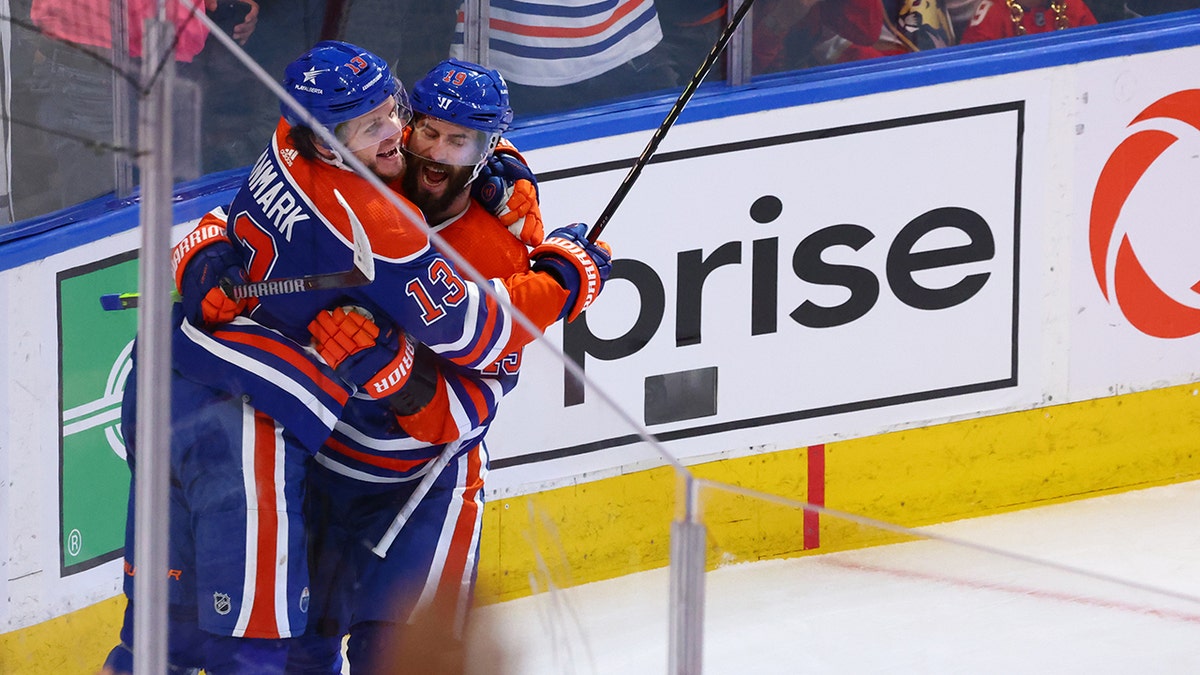
Edmonton Oilers center Adam Henrique (19) celebrates again with Edmonton Oilers center Mattias Janmark (13) in the first period against the Florida Panthers in game four of the 2024 Stanley Cup Final at Rogers Place. (Sergei Belski-USA TODAY Sports)
Game 5 will be Tuesday night in Florida at 8 p.m. ET.
Follow Fox News Digital’s sports coverage on X, and subscribe to the Fox News Sports Huddle newsletter.
Sports
Gabriel Pec helps Galaxy extend their home unbeaten streak in win over Kansas City
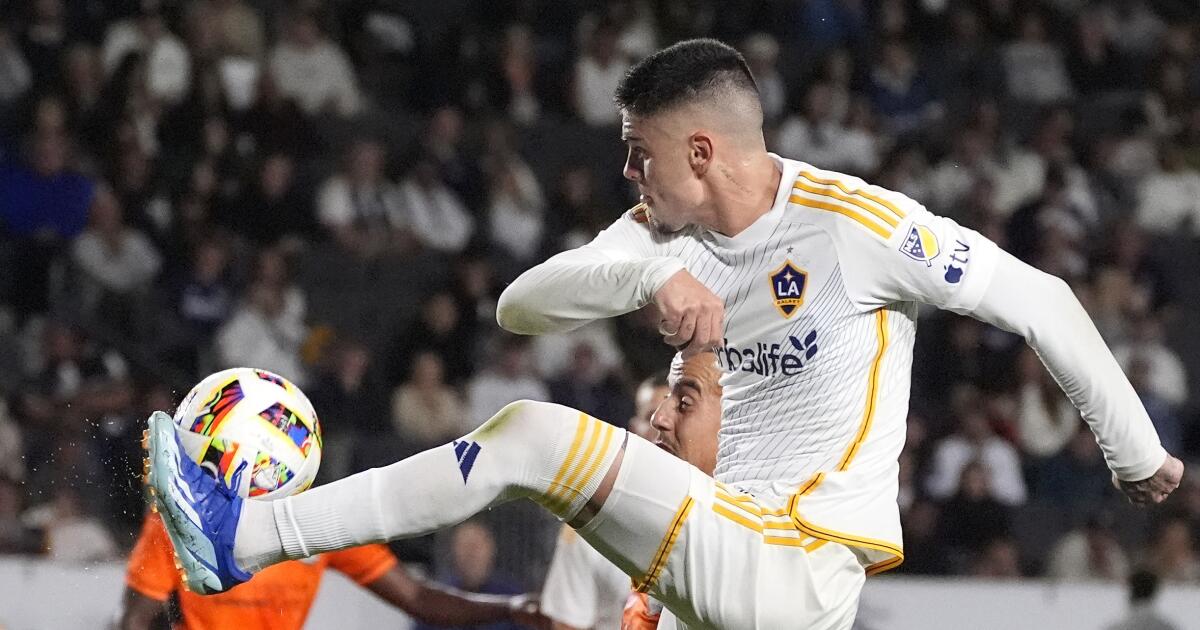
Gabriel Pec scored a goal and assisted on two others Saturday as the Galaxy opened the second half of their season with a 4-2 win over a stubborn Sporting Kansas City team at Dignity Health Sports Park.
Dejan Joveljic, Joseph Paintsil and Miguel Berry also scored for the Galaxy (8-3-7), who moved to third in the Western Conference standings, three points behind first-place Real Salt Lake. The win also kept them unbeaten through eight home games for the first time since 2016.
Only two other MLS teams — the New York Red Bulls and LAFC — have yet to lose at home this season, while the four goals matched a season high for the Galaxy.
“Home games are huge,” midfielder Diego Fagundez said. “That’s the key part, making sure that when we come home, we make it hard for teams. And we are doing that.
“We’re scoring a lot of goals, but at the same time, we need to be a little bit better defensively. It would be nice to win a game 2-0 or 1-0. I keep saying it over and over: If this team plays 90 minutes, I don’t think there’s a team that’s better than us.”
The Galaxy, returning after a two-week break and playing without playmaker Riqui Puig, who is nursing a groin injury, went ahead to stay on Joveljic’s goal in the 40th minute. After a tedious start in which the teams combined for only two shots on goal, the Galaxy got three in a matter of seconds, the final a right-footed shot from Joveljic that found the back of the net.
The sequence started with Pec putting a right-footed shot on goal from just inside the box. Kansas City keeper Tim Melia parried that away with both hands, but the ball dropped at the feet of Joveljic, who redirected it on goal. This time Melia made the save with his body as he went to the turf and the rebound hit Joveljic in the chest, allowing him to gain control and dribble past the keeper before sending a shot into the roof of the net from a right angle.
The goal was Joveljic’s team-leading 10th of the season.
Pec, who had a massive game, then doubled the lead nine minutes into the second half, running on to a chipped pass from Joveljic, dribbling into the center of the box and driving a low left-footed shot across his body and just inside the near post.
The goal was Pec’s fifth of the season, the assist Joveljic’s third.
Sporting Kansas City scored in the 66th minute when Stephen Afrifa came off the bench to one-time a left-footed shot past a sprawling John McCarthy just seconds after entering the game. But Paintsil restored the two-goal lead nine minutes later on a breakaway tally.
Defender Miki Yamane set up the goal with a long diagonal ball to Pec. Two Kansas City defenders collapsed on him, leaving Paintsil, playing for the first time in a month, open in the center of the box. Pec pushed the ball to him and the easy finish gave Paintsil his fifth goal of the season.
“It was great to get Joe back,” Galaxy coach Greg Vanney said of Paintsil, who came on at halftime. “He’s got to get back into match fitness and just get sharp again. He probably had three chances to score. He could have had a hat trick in 30 minutes.
“He does so many things at a high speed [so] repeatability is something you’ve got to work [on]. It doesn’t just come overnight.”
But Kansas City (3-10-5), which has won only one of its last 12 games, wouldn’t quit, pulling to within a goal again in the 82nd minute when defender Robert Castellanos bounced a shot off McCarthy’s outstretched right hand and in at the near post.
That was as close as Kansas City would get, though, with Berry closing the scoring for the Galaxy two minutes into stoppage time, sliding to redirect a Pec pass in with his right foot. The two-assist game was the first for Pec in MLS.
Sports
Olympic gold medalist Katie Ledecky is an ‘incredible leader for Team USA,’ swim legend Missy Franklin says
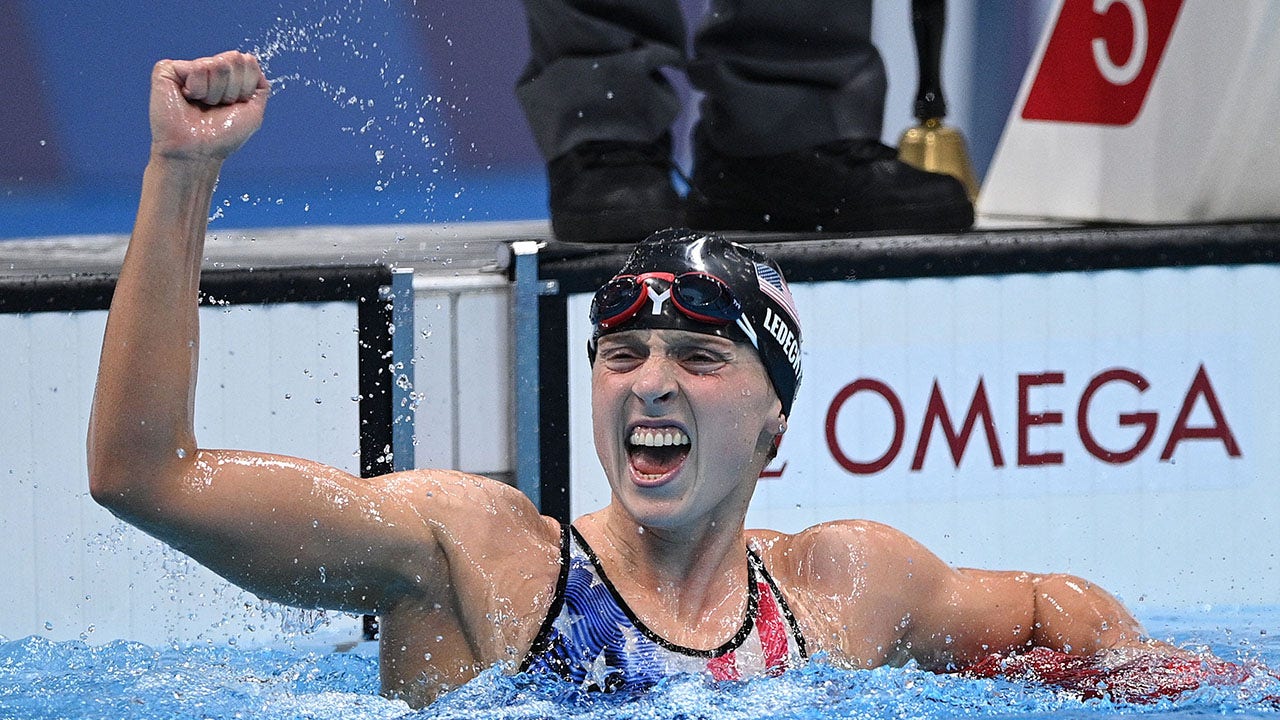
The expectations for seven-time Olympic gold medalist Katie Ledecky are high heading into the Summer Olympics, but it’s not just her dominance in the pool that makes her an invaluable member of Team USA’s success.
Fellow Olympian Missy Franklin believes it’s Ledecky’s role outside pool lanes that makes her one of the greats.
Katie Ledecky of the United States reacts after the preliminary heat for the women’s 400-meter freestyle on the first day of the 2024 U.S. Olympic team swimming trials at Lucas Oil Stadium June 15, 2024, in Indianapolis. (Al Bello/Getty Images)
Speaking to Fox News Digital ahead of the Paris Games, Franklin spoke optimistically about Ledecky’s chances at this year’s Games.
“I think she’s going to show up like she always does. Katie knows when to perform. She’s been doing it since 2012.”
It will be Ledecky’s fourth Olympics, and she is expected to solidify her spot during this weekend’s U.S. swimming trials. But the challengers are already lining up. Australia’s Ariarne Titmus and Canada’s Summer McIntosh present the biggest threat in the women’s 400-meter freestyle.
Ledecky won gold in that event in 2016 but lost to Titmus in Tokyo. McIntosh then took over the world record in the women’s 400-meter freestyle, but Titmus claimed it back later that year at the world championships.
Franklin agrees the competition will be fierce, but that’s when Ledecky shines.

USA’s Katie Ledecky celebrates after winning the final of the women’s 1500-meter freestyle during the Tokyo 2020 Olympic Games at the Tokyo Aquatics Centre in Tokyo July 28, 2021. (Oli Scarff/AFP via Getty Images)
OLYMPIC GOLD MEDALIST MISSY FRANKLIN ON THE ‘MOST EPIC MOMENT’ FOR EVERY AMERICAN SWIMMER AHEAD OF 2024 GAMES
“Katie relishes the challenge,” Franklin said. “She loves the competition. She loves having people that are going to push her to be even better.”
Ledecky, 27, already has six individual Olympic gold medals, more than any female swimmer in the history of the sport. Anything more in Paris would only compliment her legendary career. But Franklin knows Ledecky’s role in Paris goes beyond the medal count.
“I think Katie’s an incredible role model,” Franklin said. “She’s an incredible leader for Team USA. I think alongside her accomplishments in the pool, she’s also going to have amazing accomplishments outside of it when it comes to being that veteran for Team USA and really showing and leading the way with her experience or her knowledge.”

Missy Franklin, left, of the United States celebrates with teammate Katie Ledecky after the women’s 200-meter freestyle semifinals of the 16th FINA World Championships at the Kazan Arena Aug. 4, 2015, in Kazan, Russia. (Adam Pretty/Getty Images)
Ledecky was off to a strong start in the U.S. Olympic swimming trials Saturday. She finished the 400-meter freestyle with a time of 3:59.99. Her first-place finish was more than five seconds ahead of second-place finisher Paige Madden.
The final is scheduled for Saturday night.
The Associated Press contributed to this report.
Follow Fox News Digital’s sports coverage on X, and subscribe to the Fox News Sports Huddle newsletter.
-

 News1 week ago
News1 week agoIsrael used a U.S.-made bomb in a deadly U.N. school strike in Gaza
-

 World1 week ago
World1 week agoFrance to provide Ukraine with its Mirage combat aircraft
-

 World1 week ago
World1 week agoWorld leaders, veterans mark D-Day’s 80th anniversary in France
-

 World1 week ago
World1 week agoRussia-Ukraine war: List of key events, day 833
-

 News1 week ago
News1 week agoNonprofit CFO Accused of 'Simply Astonishing' Fraud
-

 Movie Reviews1 week ago
Movie Reviews1 week agoInsane Like Me? – Review | Vampire Horror Movie | Heaven of Horror
-

 Politics1 week ago
Politics1 week agoGeorge Clooney called White House to complain about Biden’s criticism of ICC and defend wife’s work: report
-

 Politics1 week ago
Politics1 week agoNewson, Dem leaders try to negotiate Prop 47 reform off California ballots, as GOP wants to let voters decide



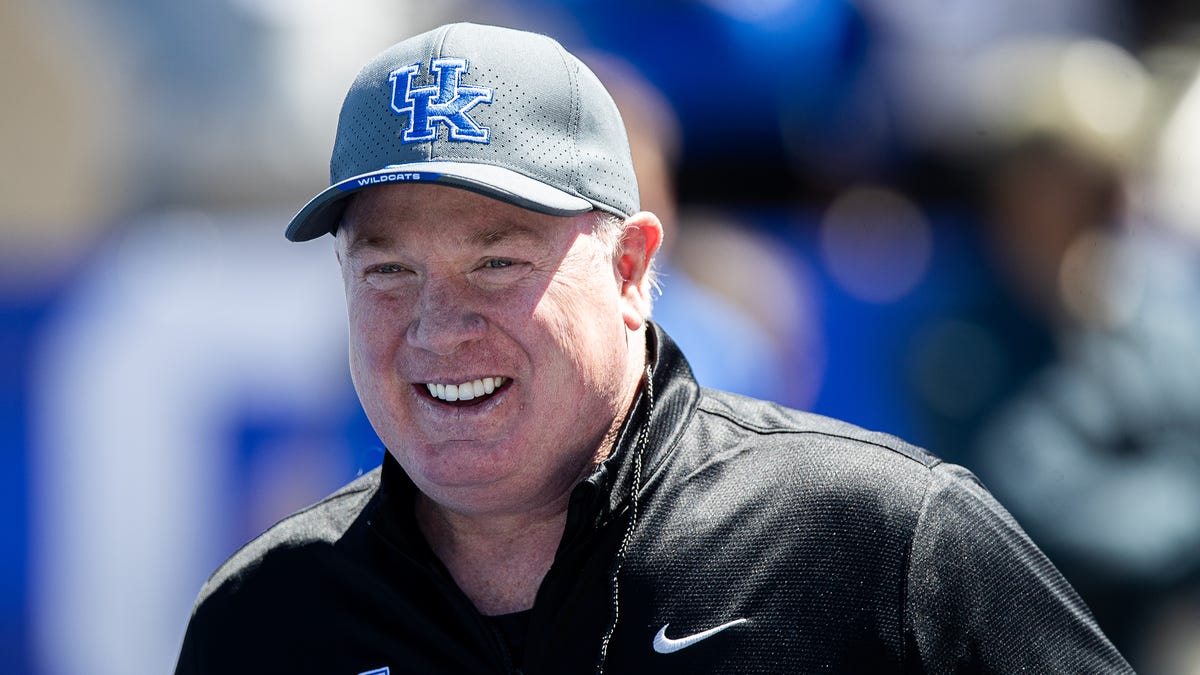



/cdn.vox-cdn.com/uploads/chorus_asset/file/25272949/retro_67_sharge_verge_sean_007.jpg)
